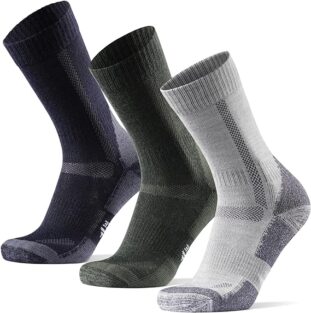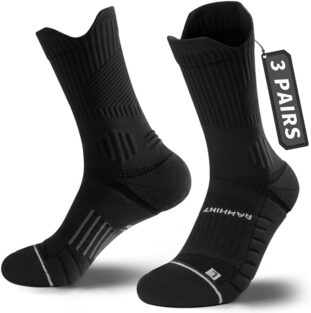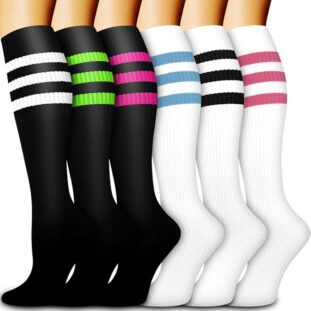Compression leg socks are specially designed to apply graduated pressure on the legs and feet to improve blood circulation. They can be beneficial for various purposes if they are properly understood and used.
This article discusses the different types of compression socks available, their benefits, and factors to consider when buying them for yourself or your elderly loved ones.
Benefits of Compression Leg Socks
Compression stockings or socks are often recommended by healthcare professionals to address poor circulation problems in seniors and promote better circulation in the legs for various medical conditions.
They are also used to enhance athletic performance, and prevent discomfort during long periods of sitting or standing.
However, like any medical intervention, there can be potential risks and considerations associated with their use.
Compression socks should be given proper care and replaced as recommended to ensure their effectiveness.
Health Hazard Considerations
Here are some health hazards and considerations related to compression stockings or socks
Difficulty Applying and Removing – Some individuals, particularly those with limited mobility or dexterity issues, may have difficulty putting on and taking off compression stockings. This can lead to frustration and potential injury if not done correctly.
Discomfort and Pain – Compression stockings can be uncomfortable for some people, particularly when they are initially worn or if they are worn for extended periods. Discomfort and pain can occur if the compression level is too high or if the stockings are not properly fitted.
Allergic Reactions – Some individuals may be sensitive or allergic to the materials used in compression stockings, such as latex or certain synthetic fibers.
This can cause skin irritation, itching, or redness. Choose compression stockings made of hypoallergenic materials if you have known sensitivities.
A personal observation the writer has encountered is that with repeated wash, latex compression socks got tighter and became more difficult to put on and take off.
Skin Irritation – Prolonged wear of compression stockings can sometimes lead to skin irritation, especially if they are too tight or if they do not fit properly. Proper sizing can help mitigate this risk.
Pressure Sores – If compression stockings are too tight or not fitted correctly, they can exert excessive pressure on certain areas of the skin, potentially causing pressure sores or ulcers.
People with diabetes or peripheral artery disease are at a higher risk for developing these complications.
Blood Clot Formation – In some cases, compression stockings may lead to blood clot formation if they are too tight or if they are worn by individuals with certain underlying medical conditions, such as deep vein thrombosis (DVT).
Always consult with a healthcare professional to determine the appropriate level of compression and whether the compression socks are suitable for your specific condition.
Complications from Incorrect Use – Wearing compression stockings when they are not needed or using the wrong compression level may not provide the intended benefits and could potentially be harmful.
To minimize the health hazards associated with compression stockings, ensure that you:
- Consult with a healthcare professional before use to determine the appropriate type, compression level, and duration of wear for your specific condition.
- Have the correct size for your legs and that the socks fit properly.
- Follow the manufacturer’s instructions and any guidance provided by your healthcare provider.
- Regularly inspect your skin for any signs of irritation or pressure sores while wearing them.
- Seek medical attention if you experience any adverse reactions or discomfort while using them.
Selection Factors to Consider
When selecting compression socks, consider these key factors:
- Purpose: Why do you need compression socks? Medical reason or other?
- Unisex or Other? Would you prefer unisex or socks specific to your gender?
- Consult a Professional: If you have a medical condition or specific concerns, consult a healthcare professional or a certified fitter for guidance on the right type and compression level of socks for your needs.
- Material: Is the material breathable and moisture-wicking to prevent discomfort and irritation.
- Color: Black or blended colors? Black is generally the most popular color for men.
- Copper Infused Socks or Other?: Are there benefits in copper infused socks?
- Compression Level: What compression level will you need?
- Size and Fit: Compression socks should fit snugly but not be too tight. Measure your ankle circumference, calf circumference, and leg length to find the right size.
- Ease of Wearing and Taking Off: How easy are they to wear and take off? Some compression socks have features like zippers or open-toe designs to make them easier to put on and take off.
- Quality and Brand: Choose reputable brands known for quality and effectiveness.
Levels of Compression
Levels of compression are typically measured in millimeters of mercury (mmHg), similar to how blood pressure is measured.
Moderate and high compression should only be used upon recommendation by a healthcare provider.
Mild Compression (15-20 mmHg)
Mild compression socks are often used for everyday wear and for individuals who want some level of support for their legs.
They can help alleviate mild leg discomfort, reduce swelling, and prevent the development of varicose veins, especially during long periods of sitting or standing, or during travel
Moderate Compression (20-30 mmHg)
Moderate compression socks offer stronger compression than mild ones and are commonly recommended for individuals with more significant leg issues.
They are often used to manage conditions like mild to moderate varicose veins, leg swelling (edema), and can aid in the prevention and treatment of deep vein thrombosis (DVT) during long trips or recovery from surgery.
High Compression (30-40 mmHg)
High compression socks provide the most significant level of pressure and are typically recommended for individuals with severe leg conditions or under medical supervision.
They are used to manage conditions like severe varicose veins, chronic venous insufficiency, lymphedema, and post-thrombotic syndrome.
High compression socks should only be worn under the guidance of a healthcare professional, as they may not be suitable for everyone and can have potential adverse effects if used incorrectly.
Types of Compression Leg Socks
There are different types of compression socks available, each serving specific purposes. 7 are discussed here.
Graduated Compression Leg Socks
Graduated compression socks provide varying levels of pressure, with the highest pressure at the ankle and gradually decreasing as they move up the leg. This design helps improve blood flow by assisting the veins in pushing blood back towards the heart.
What to Look For: Ensure that the compression level is appropriate for your condition or activity – mild, moderate, or high. If in doubt, have a chat with your healthcare professional.
Anti-Embolism Stockings
These compression stockings are primarily designed for patients who are bedridden or recovering from surgery to prevent deep vein thrombosis (DVT) and blood clots. These socks are typically available in lower pressure ranges (around 8-18 mmHg). and are usually prescribed.
Medical Compression Leg Socks
Medical compression socks are often prescribed for individuals with conditions like varicose veins, edema (swelling), or chronic venous insufficiency.
These socks are available in different lengths, including knee-high, thigh-high, and pantyhose styles.
Athletic Compression Leg Socks
Athletes often use compression socks to enhance performance, reduce muscle fatigue, and improve recovery. These socks typically provide mild to moderate compression.
What to Look For: Choose compression socks designed for your specific sport or activity. Look for moisture-wicking materials to keep your feet dry and comfortable during exercise.
Travel Compression Leg Socks
Travel compression socks are designed to prevent blood clots and swelling during long flights or car trips. They provide moderate compression.
What to Look For: Ensure a proper fit, as you will be wearing them for extended periods. Look for socks with breathable materials to prevent overheating.
Fashion Compression Leg Socks
Fashionable compression socks offer style along with the benefits of improved circulation. They come in various patterns and colors.
What to Look For: Do not just buy them for their pretty colors. Rather, ensure they provide the right compression level for your needs, especially if you have a medical condition requiring compression therapy.
Maternity Compression Leg Socks
Maternity compression socks are designed to support the legs and reduce swelling during pregnancy.
What to Look For: Select maternity-specific compression leg socks, as they are designed to accommodate a growing belly while providing the necessary support.
Conclusion – Compression Leg Socks
Overall, when used as recommended by a healthcare provider and with proper care and attention to fit and comfort, compression leg socks or stockings can be a beneficial tool for managing various medical conditions and reducing the risk of certain complications.
If you like this article, please leave a comment below.
Related Articles
- What is the #1 Best treatment for Leg Cramps? Shocker
- The Best Products that Can Help Improve Poor Blood Circulation
- Poor Circulation Problems in Seniors – The Real Dangers
- The Causes of Poor Blood Circulation in Aging Adults
- Foot Problems and Diabetes. Why Important for Seniors?
- 7 Top Copper Fit Compression Socks for Women
FAQ
What compression level is best for me?
The compression level depends on your needs. For mild swelling or discomfort, 15-20 mmHg is suitable. For more serious issues like varicose veins or deep vein thrombosis, consult a healthcare professional for higher compression levels, typically between 20-30 mmHg or higher.
What size should I choose?
Measure your calf circumference and ankle circumference for accurate sizing. Refer to the sizing chart provided by the manufacturer. It’s important for compression leg socks that they fit snugly but not too tight, to ensure proper circulation and effectiveness.
Are there specific features I should look for in compression leg socks?
Yes. Look for moisture-wicking materials to keep your legs dry and comfortable, seamless designs to prevent rubbing and irritation, reinforced heels and toes for durability, and options with adjustable closures or silicone grips to ensure they stay in place throughout the day.
References
Merck’s Manual. Heart Attack https://www.merckmanuals.com/home/quick-facts-heart-and-blood-vessel-disorders/coronary-artery-disease/heart-attack?query=circulation%20problems




